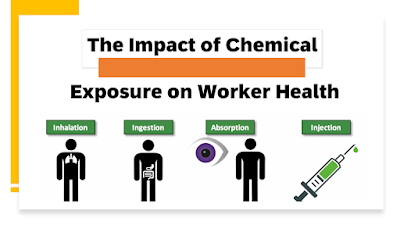The Impact of Chemical Exposure on
Employee Health
The Impact of Chemical Exposure on Employee Health
Introduction
Exposure to chemicals is one of the serious occupational
health issues that can affect the health and wellbeing of employees in any
industries especially the process industries. The increased use of chemicals over
the years in various industries has led to an increase in the number of employees
exposed to hazardous chemicals in various ways. Employees in different
industries such as agriculture, manufacturing, healthcare, construction, and
mining are exposed to chemicals that can cause serious health problems against
the short term and long term exposures.
Inhalation, ingestion, and skin contact are the different ways of chemical exposures in the workplace. Employees who are exposed to chemicals can develop various health problems, including respiratory diseases, skin conditions, cancer, and neurological disorders and its defendant on various factors. In this article, we will discuss the impact of chemical exposure on employee health and the steps that employers can take to protect employees from chemical exposure.
Health Risks of Chemical Exposure
The exposure time and level most matters here. The health risks of chemical exposure depend on the type and level of exposure. Employees who are exposed to chemicals for a short period may experience mild symptoms such as dizziness, headaches, and nausea. However, long term exposure to chemicals can lead to serious health problems such as cancer, reproductive disorders, and neurological disorders.
Respiratory Diseases
The exposure impact resulting the respiratory related occupational
diseases is very danger. Employees who are exposed to chemicals such as
asbestos, silica, and benzene are at risk of developing respiratory diseases.
These chemicals can damage the lungs and cause respiratory problems such as
asthma, chronic obstructive pulmonary disease (COPD), and lung cancer. Employees
who work in industries such as construction, mining, and manufacturing are at a
higher risk of developing respiratory diseases.
Skin Conditions
The impact of chemical exposure on skin conditions resulting various health issues to employees. Chemicals such as solvents, acids, and alkalis can cause skin irritation, dermatitis, and other skin conditions. Employees who are exposed to these chemicals can develop rashes, blisters, and dry skin. Prolonged exposure to these chemicals can also lead to more serious skin conditions such as skin cancer.
Cancer
The carcinogenic chemical exposure is serious health hazard to employees. Some chemicals such as benzene, asbestos, and chromium are known to cause cancer. Employees who are exposed to these chemicals are at a higher risk of developing cancer. Cancer caused by chemical exposure can affect different parts of the body, including the lungs, liver, and bladder.
Neurological Disorders
Chemicals such as lead and mercury can damage the nervous
system and cause neurological disorders. Employees who are exposed to these
chemicals can develop symptoms such as tremors, memory loss, and numbness.
Prolonged exposure to these chemicals can also lead to more serious
neurological disorders such as Parkinson's disease.
Steps Employers Can Take to Protect Employees
All employers have a prime responsibility to protect employees from chemical exposure. The following are some steps that employers can take to protect employees from chemical exposure:
Conducting a Risk Assessment
The expert committee should conduct a risk assessment to identify the chemicals that employees are exposed to and the level of exposure. This will help employers to determine the appropriate measures to protect employees from chemical exposure.
Substitution
The hierarchy control to be explored here for the
effective control of the chemical exposure. Employers should consider
substituting hazardous chemicals with less hazardous alternatives. For example,
instead of using solvents that are harmful to employees' health, employers can
use water based solutions that are less harmful.
Ensuring Safety at Heights in Industry
Engineering Controls
The process activities in the industry may be done with the machines instead involving the employees for the operational activities. Employers can use engineering controls to reduce the level of chemical exposure. Engineering controls include ventilation systems, enclosures, and barriers. These controls can help to reduce the level of chemical exposure by limiting the amount of chemicals that employees are exposed to.
Personal Protective Equipment
The personal protective equipment matrix to be developed
for the handling and working with the chemicals and all employees to trained. Employers
should provide employees with all adequate personal protective equipment (PPE)
such as respirators, gloves, and goggles. PPE can help to protect employees
from chemical exposure by reducing the amount of chemicals that employees come
into contact with.
Hot Work Safety - A Complete Guide to
Training
Employers should provide employees with training on how to work safely with chemicals. Employees should be trained on how to use PPE, how to handle chemicals safely, and how to respond in case of a chemical spill or exposure.
Conclusion
Chemical exposure is a serious occupational health issue that can have a significant impact on employee health. Employees who are exposed to hazardous chemicals are at risk of developing various health problems, including respiratory diseases, skin conditions, cancer, and neurological disorders.
Employers have a responsibility to protect employees from chemical exposure. They can take steps such as conducting risk assessments, substituting hazardous chemicals with less harmful alternatives, using engineering controls, providing personal protective equipment, and providing training to employees on how to work safely with chemicals.
By taking these steps, employers can create a safe and healthy
work environment for their employees and minimize the risk of chemical
exposure. It is important for employers to prioritize the health and well-being
of their employees and take the necessary steps to protect them from chemical
exposure.
Animation of Refinery Fire | CSB
The Importance of Spill Control

No comments:
Post a Comment